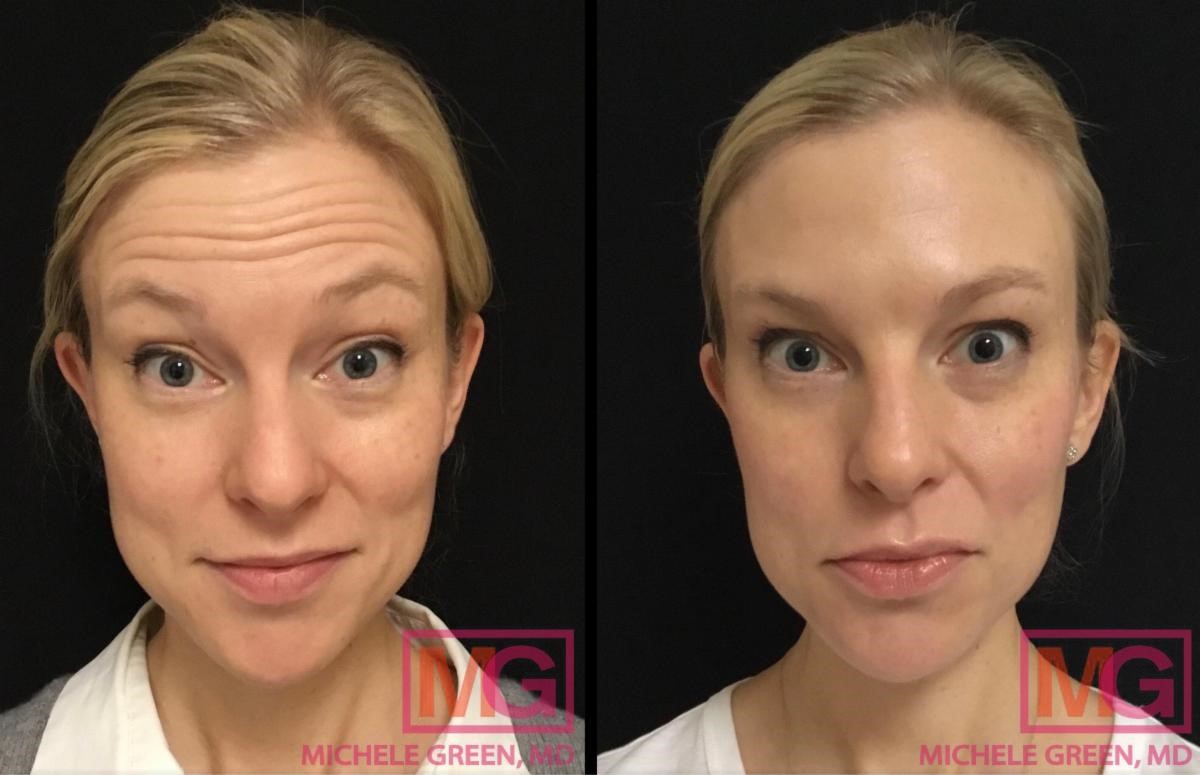What Causes an Eyebrow Droop After Botox
There is a chance that rare complications can occur after Botox injections. A common example are droopy eyelids (also known as ptosis). The levator is the muscle that is responsible for maintaining the eyelids in their normal position. However, in some instances, Botox migrates from the injected treatment area and ends up in the levator muscle. When this occurs, it causes drooping eyelids or droopy eyebrow.Botox can also be injected into the forehead to reduce forehead wrinkles. Botox injections of the forehead typically involves the frontalis muscle which is responsible for raising the eyebrows. An eyebrow droop can also occur as a result of over-relaxation of the frontalis muscle, while trying to erase horizontal forehead lines and wrinkles. The frontalis muscle needs a decent amount of movement in order to maintain the proper brow lift. In some instances, Botox injections can cause the brow to descend, causing crowding of the upper eyelids, giving a drooping appearance. It is important when considering Botox injections to be sure to consult an experienced dermatologist who understands facial anatomy, and who knows where to inject Botox and the proper amount to avoid migration of the neurotoxin.
What is Botox and how does it work?
Botox injections (botulinum toxin) works by inhibiting the nerve cells that are responsible for sending specific signals to muscles causing them to contract. Botox weakens the facial muscles which are responsible for causing fine lines and wrinkles. Once the muscles are weakened, you’ll still be able to make facial expressions, however, they will be less exaggerated. Botox is an FDA approved cosmetic procedure that can be used for treating forehead lines, forehead wrinkles, frown lines, and crow’s feet. Once injected, the neurotoxin will begin blocking the connection between the nerve and the muscle – within 7-10 days results will be noticed. After receiving your Botox treatment, you may develop some minor swelling or bruising. These side effects typically resolve quickly.
What to do if you have an eyebrow droop after Botox?
You have probably heard the term “bad Botox” well this refers to having an unfavorable result from Botox injections. This typically happens with inexperienced injectors, who lack knowledge of facial anatomy, perform proper injection placement and units of Botox. When Botox injections are injected into the wrong area, or too much Botox is injected into the wrong area,this can result in facial asymmetry, eyebrow drooping or eyelid drooping.
Experienced injectors provide the correct injection technique that will prevent “bad Botox” from happening. An error, such as injecting Botox too low down in the forehead, can cause brow ptosis. The injection of Botox is an art and should not be taken lightly. It is important to closely examine the patient’s facial structure to determine the proper injection placement.
In addition, if you do end up with eyelid ptosis after receiving injectables, there are eye drops such as Apraclonidine which can help with eyelid droops. Your dermatologist can also inject more Botox in the lower forehead, paralyzing the depressor muscle that’s responsible for causing the eyebrow droop; this can counteract the relaxation of eyebrow muscles.
If you are experiencing eyebrow unevenness this can also be corrected, and you do not have to wait for the Botox injections to wear off. Eyebrow unevenness can be corrected by injecting a little more neurotoxin into the side that is lower. This will eventually correct the asymmetry.
The best outcome one can have from getting Botox injections is a relaxed, refreshed and more youthful appearance, without seeming as though one has done anything.

Before and after Botox treatment (glabella & forehead) 2 weeks apart
Other ways to fix droopy eyelids
In some cases where patients have excess sagging skin on their upper eyelid, which cannot be treated with Botox or other Botox alternatives, such as Dysport or Xeomin. For these situations, blepharoplasty (also called eyelid surgery) is the best treatment option. Blepharoplasty is a cosmetic surgery which removes excess eyelid skin from the upper lid and can also reduce the bags or fat from the eyes. Plastic surgery can be intimidating, but finding the right plastic surgeon will help ease any concerns that you may have. Some patients decide to have a facelift at the same time as a blepharoplasty. It is always important to consult a board certified plastic surgeon when considering cosmetic surgery.
What is the best way to avoid a droop after Botox?
There is a chance that rare complications can occur after Botox injections, such as a ptosis or droopy eyelid. It is always best to consult with an experienced board-certified dermatologist or plastic surgeon when receiving Botox or other cosmetic treatments. This will help you avoid complications from occurring.
Botox injections are not permanent, and the effects eventually wear off after 3 to 4 months. If you have a proof from Botox, the droop will go away in a number of weeks, even without any treatment. While an eyebrow droop may seem apparent immediately after your Botox treatment you should always wait up to 14 days before getting any additional Botox injections to ensure you are truly experiencing an eyebrow droop. The reason is that Botox injections can take up to 14 days to see the full effects. Therefore, it is best to wait two weeks after treatment before deciding if you need additional Botox injected.
You can prevent “bad botox” by seeking an experienced injector with extensive knowledge in facial anatomy and most importantly don’t bargain shop for your facial treatments. There is no amount of money saved that can compensate for a “bad botox” experience.
To schedule a consultation with Dr. Michele Green, please contact our Upper East Side NY based office today or call 212-535-3088 to learn more about whether Botox, or a combination of Botox injections with Dermal Fillers such as Juvederm, Kybella, Radiesse or Restylane is best suited for your needs.
 212-535-3088
212-535-3088